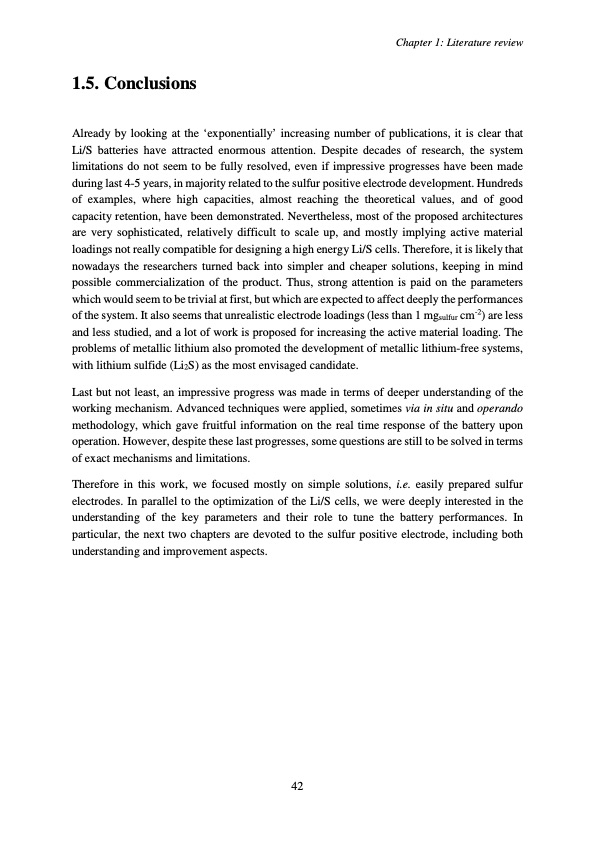
PDF Publication Title:
Text from PDF Page: 046
1.5. Conclusions Already by looking at the ‘exponentially’ increasing number of publications, it is clear that Li/S batteries have attracted enormous attention. Despite decades of research, the system limitations do not seem to be fully resolved, even if impressive progresses have been made during last 4-5 years, in majority related to the sulfur positive electrode development. Hundreds of examples, where high capacities, almost reaching the theoretical values, and of good capacity retention, have been demonstrated. Nevertheless, most of the proposed architectures are very sophisticated, relatively difficult to scale up, and mostly implying active material loadings not really compatible for designing a high energy Li/S cells. Therefore, it is likely that nowadays the researchers turned back into simpler and cheaper solutions, keeping in mind possible commercialization of the product. Thus, strong attention is paid on the parameters which would seem to be trivial at first, but which are expected to affect deeply the performances of the system. It also seems that unrealistic electrode loadings (less than 1 mgsulfur cm-2) are less and less studied, and a lot of work is proposed for increasing the active material loading. The problems of metallic lithium also promoted the development of metallic lithium-free systems, with lithium sulfide (Li2S) as the most envisaged candidate. Last but not least, an impressive progress was made in terms of deeper understanding of the working mechanism. Advanced techniques were applied, sometimes via in situ and operando methodology, which gave fruitful information on the real time response of the battery upon operation. However, despite these last progresses, some questions are still to be solved in terms of exact mechanisms and limitations. Therefore in this work, we focused mostly on simple solutions, i.e. easily prepared sulfur electrodes. In parallel to the optimization of the Li/S cells, we were deeply interested in the understanding of the key parameters and their role to tune the battery performances. In particular, the next two chapters are devoted to the sulfur positive electrode, including both understanding and improvement aspects. 42 Chapter 1: Literature reviewPDF Image | Accumulateur Lithium Soufre

PDF Search Title:
Accumulateur Lithium SoufreOriginal File Name Searched:
WALUS_2015_archivage.pdfDIY PDF Search: Google It | Yahoo | Bing
Sulfur Deposition on Carbon Nanofibers using Supercritical CO2 Sulfur Deposition on Carbon Nanofibers using Supercritical CO2. Gamma sulfur also known as mother of pearl sulfur and nacreous sulfur... More Info
CO2 Organic Rankine Cycle Experimenter Platform The supercritical CO2 phase change system is both a heat pump and organic rankine cycle which can be used for those purposes and as a supercritical extractor for advanced subcritical and supercritical extraction technology. Uses include producing nanoparticles, precious metal CO2 extraction, lithium battery recycling, and other applications... More Info
| CONTACT TEL: 608-238-6001 Email: greg@infinityturbine.com | RSS | AMP |